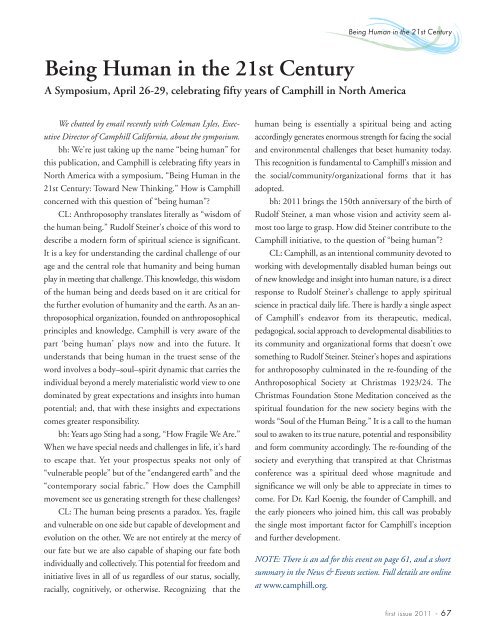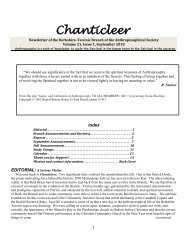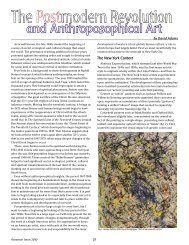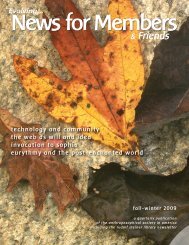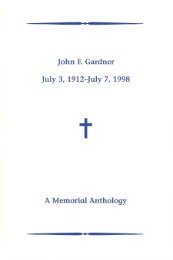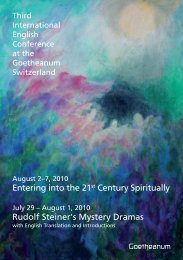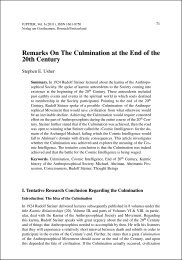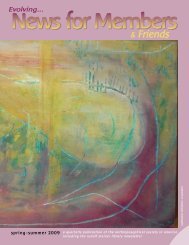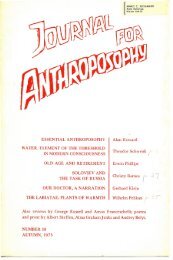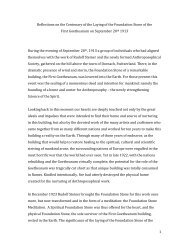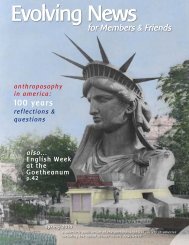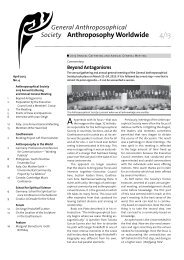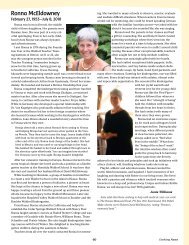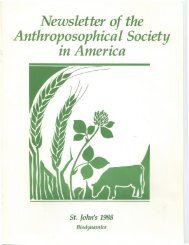Rudolf Steiner's Vision for the Future - Anthroposophical Society in ...
Rudolf Steiner's Vision for the Future - Anthroposophical Society in ...
Rudolf Steiner's Vision for the Future - Anthroposophical Society in ...
Create successful ePaper yourself
Turn your PDF publications into a flip-book with our unique Google optimized e-Paper software.
Be<strong>in</strong>g Human <strong>in</strong> <strong>the</strong> 21st Century<br />
We chatted by email recently with Coleman Lyles, Exec-<br />
utive Director of Camphill Cali<strong>for</strong>nia, about <strong>the</strong> symposium.<br />
bh: We’re just tak<strong>in</strong>g up <strong>the</strong> name “be<strong>in</strong>g human” <strong>for</strong><br />
this publication, and Camphill is celebrat<strong>in</strong>g fifty years <strong>in</strong><br />
North America with a symposium, “Be<strong>in</strong>g Human <strong>in</strong> <strong>the</strong><br />
21st Century: Toward New Th<strong>in</strong>k<strong>in</strong>g.” How is Camphill<br />
concerned with this question of “be<strong>in</strong>g human”?<br />
CL: Anthroposophy translates literally as “wisdom of<br />
<strong>the</strong> human be<strong>in</strong>g.” <strong>Rudolf</strong> Ste<strong>in</strong>er’s choice of this word to<br />
describe a modern <strong>for</strong>m of spiritual science is significant.<br />
It is a key <strong>for</strong> understand<strong>in</strong>g <strong>the</strong> card<strong>in</strong>al challenge of our<br />
age and <strong>the</strong> central role that humanity and be<strong>in</strong>g human<br />
play <strong>in</strong> meet<strong>in</strong>g that challenge. This knowledge, this wisdom<br />
of <strong>the</strong> human be<strong>in</strong>g and deeds based on it are critical <strong>for</strong><br />
<strong>the</strong> fur<strong>the</strong>r evolution of humanity and <strong>the</strong> earth. As an anthroposophical<br />
organization, founded on anthroposophical<br />
pr<strong>in</strong>ciples and knowledge, Camphill is very aware of <strong>the</strong><br />
part ‘be<strong>in</strong>g human’ plays now and <strong>in</strong>to <strong>the</strong> future. It<br />
understands that be<strong>in</strong>g human <strong>in</strong> <strong>the</strong> truest sense of <strong>the</strong><br />
word <strong>in</strong>volves a body–soul–spirit dynamic that carries <strong>the</strong><br />
<strong>in</strong>dividual beyond a merely materialistic world view to one<br />
dom<strong>in</strong>ated by great expectations and <strong>in</strong>sights <strong>in</strong>to human<br />
potential; and, that with <strong>the</strong>se <strong>in</strong>sights and expectations<br />
comes greater responsibility.<br />
bh: Years ago St<strong>in</strong>g had a song, “How Fragile We Are.”<br />
When we have special needs and challenges <strong>in</strong> life, it’s hard<br />
to escape that. Yet your prospectus speaks not only of<br />
“vulnerable people” but of <strong>the</strong> “endangered earth” and <strong>the</strong><br />
“contemporary social fabric.” How does <strong>the</strong> Camphill<br />
movement see us generat<strong>in</strong>g strength <strong>for</strong> <strong>the</strong>se challenges?<br />
CL: The human be<strong>in</strong>g presents a paradox. Yes, fragile<br />
and vulnerable on one side but capable of development and<br />
evolution on <strong>the</strong> o<strong>the</strong>r. We are not entirely at <strong>the</strong> mercy of<br />
our fate but we are also capable of shap<strong>in</strong>g our fate both<br />
<strong>in</strong>dividually and collectively. This potential <strong>for</strong> freedom and<br />
<strong>in</strong>itiative lives <strong>in</strong> all of us regardless of our status, socially,<br />
racially, cognitively, or o<strong>the</strong>rwise. Recogniz<strong>in</strong>g that <strong>the</strong><br />
Be<strong>in</strong>g Human <strong>in</strong> <strong>the</strong> 21st Century<br />
A Symposium, April 26-29, celebrat<strong>in</strong>g fifty years of Camphill <strong>in</strong> North America<br />
human be<strong>in</strong>g is essentially a spiritual be<strong>in</strong>g and act<strong>in</strong>g<br />
accord<strong>in</strong>gly generates enormous strength <strong>for</strong> fac<strong>in</strong>g <strong>the</strong> social<br />
and environmental challenges that beset humanity today.<br />
This recognition is fundamental to Camphill’s mission and<br />
<strong>the</strong> social/community/organizational <strong>for</strong>ms that it has<br />
adopted.<br />
bh: 2011 br<strong>in</strong>gs <strong>the</strong> 150th anniversary of <strong>the</strong> birth of<br />
<strong>Rudolf</strong> Ste<strong>in</strong>er, a man whose vision and activity seem almost<br />
too large to grasp. How did Ste<strong>in</strong>er contribute to <strong>the</strong><br />
Camphill <strong>in</strong>itiative, to <strong>the</strong> question of “be<strong>in</strong>g human”?<br />
CL: Camphill, as an <strong>in</strong>tentional community devoted to<br />
work<strong>in</strong>g with developmentally disabled human be<strong>in</strong>gs out<br />
of new knowledge and <strong>in</strong>sight <strong>in</strong>to human nature, is a direct<br />
response to <strong>Rudolf</strong> Ste<strong>in</strong>er’s challenge to apply spiritual<br />
science <strong>in</strong> practical daily life. There is hardly a s<strong>in</strong>gle aspect<br />
of Camphill’s endeavor from its <strong>the</strong>rapeutic, medical,<br />
pedagogical, social approach to developmental disabilities to<br />
its community and organizational <strong>for</strong>ms that doesn’t owe<br />
someth<strong>in</strong>g to <strong>Rudolf</strong> Ste<strong>in</strong>er. Ste<strong>in</strong>er’s hopes and aspirations<br />
<strong>for</strong> anthroposophy culm<strong>in</strong>ated <strong>in</strong> <strong>the</strong> re-found<strong>in</strong>g of <strong>the</strong><br />
<strong>Anthroposophical</strong> <strong>Society</strong> at Christmas 1923/24. The<br />
Christmas Foundation Stone Meditation conceived as <strong>the</strong><br />
spiritual foundation <strong>for</strong> <strong>the</strong> new society beg<strong>in</strong>s with <strong>the</strong><br />
words “Soul of <strong>the</strong> Human Be<strong>in</strong>g.” It is a call to <strong>the</strong> human<br />
soul to awaken to its true nature, potential and responsibility<br />
and <strong>for</strong>m community accord<strong>in</strong>gly. The re-found<strong>in</strong>g of <strong>the</strong><br />
society and everyth<strong>in</strong>g that transpired at that Christmas<br />
conference was a spiritual deed whose magnitude and<br />
significance we will only be able to appreciate <strong>in</strong> times to<br />
come. For Dr. Karl Koenig, <strong>the</strong> founder of Camphill, and<br />
<strong>the</strong> early pioneers who jo<strong>in</strong>ed him, this call was probably<br />
<strong>the</strong> s<strong>in</strong>gle most important factor <strong>for</strong> Camphill’s <strong>in</strong>ception<br />
and fur<strong>the</strong>r development.<br />
NOTE: There is an ad <strong>for</strong> this event on page 61, and a short<br />
summary <strong>in</strong> <strong>the</strong> News & Events section. Full details are onl<strong>in</strong>e<br />
at www.camphill.org.<br />
first issue 2011 • 67


